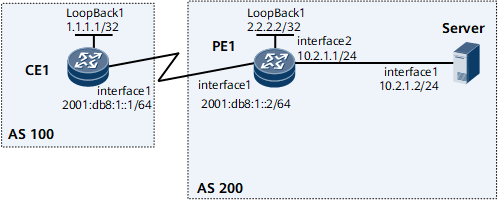Example for Configuring Dynamic BGP VPNv6 Flow Specification
This section provides an example for configuring dynamic BGP VPNv6 Flow Specification to allow BGP VPNv6 Flow Specification routes to be transmitted and traffic filtering policies to be generated. The policies improve security of devices in VPNs.
Networking Requirements
Figure 1 shows a VPN, where CE1 belongs to AS 100, PE1 and the server belong to AS 200, and PE1 is a network ingress of AS 200. AS 200 communicates with AS 100 through PE1.
If an attack source exists in AS 100, attack traffic is transmitted to AS 200 through PE1, posing a threat to AS 200. In this case, it is required that dynamic BGP VPNv6 Flow Specification be configured to address this problem. To meet the requirement, you need to deploy a traffic analysis server (the server in Figure 1) and establish a BGP VPNv6 Flow Specification peer relationship between the server and PE1. PE1 samples traffic periodically and sends the sampled traffic to the traffic analysis server. The traffic analysis server generates a BGP VPNv6 Flow Specification route based on the characteristics of sampled attack traffic and sends the route to PE1. PE1 then converts the route into a traffic filtering policy to filter and control attack traffic, ensuring the security of VPN services in AS 200.
Configuration Roadmap
The configuration roadmap is as follows:
Configure an IP address for each involved interface.
Create a VPN instance on PE1 and the server and bind the VPN instance to PE1's interface that is connected to CE1.
Establish a BGP VPNv6 Flow Specification peer relationship between PE1 and the server so that the generated BGP VPNv6 Flow Specification route can be sent to PE1 and be used by PE1 to generate a traffic filtering policy.

The traffic analysis server is a third-party device and must have the capability of establishing a BGP VPNv6 Flow Specification peer relationship.
Data Preparation
AS number (100) of CE1 and the AS number (200) of PE1 and the server
Name of a VPN instance (vpna)
Procedure
- Assign an IP address and a mask to each interface.
For configuration details, see "Configuration Files" in this section.
- Create a VPN instance and bind the VPN instance to PE1's interface that is connected to CE1.
# Configure PE1.
[~PE1] ip vpn-instance vpna [*PE1-vpn-instance-vpna] ipv6-family [*PE1-vpn-instance-vpna-af-ipv6] route-distinguisher 100:1 [*PE1-vpn-instance-vpna-af-ipv6] vpn-target 111:1 export-extcommunity [*PE1-vpn-instance-vpna-af-ipv6] vpn-target 111:1 import-extcommunity [*PE1-vpn-instance-vpna-af-ipv6] commit [~PE1-vpn-instance-vpna-af-ipv6] quit [~PE1-vpn-instance-vpna] ipv4-family [~PE1-vpn-instance-vpna] route-distinguisher 100:1 [*PE1-vpn-instance-vpna-af-ipv4] commit [~PE1-vpn-instance-vpna-af-ipv4] quit [~PE1-vpn-instance-vpna] quit [~PE1] interface GigabitEthernet0/1/0 [~PE1-GigabitEthernet0/1/0] undo shutdown [*PE1-GigabitEthernet0/1/0] ip binding vpn-instance vpna [*PE1-GigabitEthernet0/1/0] ipv6 enable [*PE1-GigabitEthernet0/1/0] ipv6 address 2001:db8:1::2 64 [*PE1-GigabitEthernet0/1/0] commit [~PE1-GigabitEthernet0/1/0] quit [~PE1] interface GigabitEthernet0/1/8 [~PE1-GigabitEthernet0/1/8] undo shutdown [*PE1-GigabitEthernet0/1/8] ip address 10.2.1.1 255.255.255.0 [*PE1-GigabitEthernet0/1/8] commit [~PE1-GigabitEthernet0/1/8] quit
- Establish a BGP VPNv6 Flow Specification peer relationship.
# Configure PE1.
[~PE1]bgp 200 [*PE1-bgp] peer 10.2.1.2 as-number 200 [*PE1-bgp] vpn-instance vpna [*PE1-bgp-instance-vpna] quit [*PE1-bgp] ipv6-flow vpn-instance vpna [*PE1-bgp-flow-vpna] quit [*PE1-bgp] ipv6-flow vpnv6 [*PE1-bgp-af-flow-6-vpnv6] peer 10.2.1.2 enable [*PE1-bgp-af-flow-6-vpnv6] commit [~PE1-bgp-af-flow-6-vpnv6] quit [~PE1-bgp] quit
- Verify the configuration.
# Check whether the BGP VPNv6 Flow Specification peer relationship with the server is established on PE1. The command output shows that the peer relationship is established. In addition, the BGP VPN IPv6 Flow Specification peer relationship is established between CE1 and PE1.
<PE1> display bgp flow vpnv6 all peer BGP local router ID : 2001:db8:1::2 Local AS number : 200 Total number of peers : 2 Peers in established state : 2 Peer V AS MsgRcvd MsgSent OutQ Up/Down State PrefRcv 10.2.1.2 4 200 1076 1067 0 15:30:19 Established 1 Peer of for vpn instance : VPN-Instance vpna, Router ID 2001:db8:1::2: Peer V AS MsgRcvd MsgSent OutQ Up/Down State PrefRcv 2001:db8:1::1 4 100 1057 1058 0 15:19:07 Established 0
# Check information about the BGP VPNv6 Flow Specification routes received by PE1. The command output also shows information about the received BGP VPN IPv6 Flow Specification routes.
<PE1> display bgp flow vpnv6 all routing-table BGP Local router ID is 2001:db8:1::2 Status codes: * - valid, > - best, d - damped, x - best external, a - add path, h - history, i - internal, s - suppressed, S - Stale Origin : i - IGP, e - EGP, ? - incomplete RPKI validation codes: V - valid, I - invalid, N - not-found Total number of routes from all PE: 1 * > ReIndex : 536870913 Dissemination Rules: Src. Port : eq 159 MED : 0 PrefVal : 0 LocalPref: 100 Path/Ogn : i VPN-Instance vpna, Router ID 2001:db8:1::2: Total Number of Routes: 1 * > ReIndex : 1 Dissemination Rules: Src. Port : eq 159 MED : 0 PrefVal : 0 LocalPref: 100 Path/Ogn : i# Specify ReIndex of the BGP VPNv6 Flow Specification route to check the traffic filtering rule carried in the route.
<PE1> display bgp flow vpnv6 all routing-table 536870913 BGP local router ID : 2001:db8:1::2 Local AS number : 200 ReIndex : 536870913 Order : 0 Dissemination Rules : Src. Port : eq 159 BGP flow-vpnv6 routing table entry information of 536870913: Route Distinguisher: 200:1 Match action : apply deny From: 10.2.1.2 (10.2.1.2) Route Duration: 0d13h59m46s Ext-Community: RT <111 : 1> AS-path Nil, origin igp, MED 0, localpref 100, pref-val 0, valid, internal, best, pre 255 Not advertised to any peer yet
Configuration Files
CE1 configuration file
# sysname CE1 # interface GigabitEthernet0/1/0 undo shutdown ip address 2001:db8:1::1 255.255.255.0 # bgp 100 peer 2001:db8:1::2 as-number 200 # ipv6-family unicast undo synchronization peer 2001:db8:1::2 enable # ipv6-family flow peer 2001:db8:1::2 enable # returnPE1 configuration file
# sysname PE1 # ip vpn-instance vpna ipv6-family route-distinguisher 100:1 apply-label per-instance vpn-target 111:1 export-extcommunity vpn-target 111:1 import-extcommunity ipv4-family route-distinguisher 100:1 apply-label per-instance # interface GigabitEthernet0/1/0 undo shutdown ip binding vpn-instance vpna ipv6 enable ipv6 address 2001:db8:1::2/64 # interface GigabitEthernet0/1/8 undo shutdown ip address 10.2.1.1 255.255.255.0 # bgp 200 peer 10.2.1.2 as-number 200 # ipv6-family unicast undo synchronization peer 10.2.1.2 enable # vpn-instance vpna # ipv6-flow vpn-instance vpna # ipv6-flow vpnv6 policy vpn-target peer 10.2.1.2 enable # return
